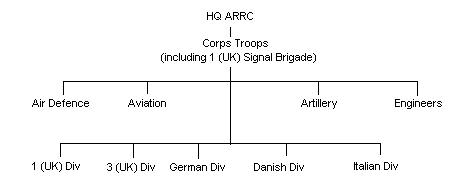|
The concept of the
Allied Rapid Reaction Corps was initiated by the NATO Defence
Planning Committee in May 1991. The concept called for the creation
of Rapid Reaction Forces to meet the requirements of future
challenges within the alliance. The ARRC provides the Supreme Allied
Commander Europe with a multinational corps sized grouping in which
forward elements can be ready to deploy within 14 days (lead
elements and recce parties at very short notice).
As stated by SHAPE the mission of the ARRC is:
“HQ ARRC, as a High Readiness Force (Land) HQ, is prepared to deploy
under NATO, EU or coalition auspices to a designated area, to
undertake combined and joint operations across the operational
spectrum as:
These formations will
enable support crisis support management options or the sustainment
of ongoing operations.”
Currently the ARRC trains for missions across the spectrum of
operations from deterrence and crisis management to regional
conflict. Currently (late 2010) Headquarters ARRC is located at
Innsworth (UK), with a peace-time establishment of about 400
personnel. It comprises staff from all the contributing nations. As
the Framework Nation, the UK provides the infrastructure,
administrative support, communications and 60 per cent of the staff.
The Commander (COMARRC) and Chief of Staff are UK 3 Star and 2 Star
Generals and the Deputy Commander is an Italian 2 Star General. The
other appointments, as with the training and exercise costs, are
shared among the contributing nations.
Outline Composition of the ARRC (Allied Command Europe Rapid
Reaction Corps)
For operations HQ ARRC might have some of the following formations
under command:

The operational
organisation, composition and size of the ARRC would depend on the
type of crisis, area of crisis, its political significance, and the
capabilities and availability of lift assets, the distances to be
covered and the infrastructure capabilities of the nation receiving
assistance. It is considered that a four division ARRC would be the
maximum employment structure.
Command Posts and Deployment
Due to the need to be able to respond flexibly to the whole range of
potential operations, HQ ARRC has developed the capability for
rapidly deployable and modular HQs. Deployment begins with the
despatch of a Forward Liaison and Reconnaissance Group (FLRG) within
48 hours of the order being given which can then be quickly followed
up.
Within four days the key enablers from 1 (UK) Signal Bde would be
within theatre and three days later HQ ARRC Forward and HQ Rear
Support Command (RSC) Forward – as required - could be established.
The forward-deployed HQs are light, mobile and C-130 transportable.
While there is a standard ‘default’ setting for personnel numbers,
the actual staff composition is ‘tailored’ to the task and can vary
from approximately 50 to 150 staff, depending on the requirement.
The ‘in-theatre’ task would then be supported by the remainder of
the staff, using sophisticated ‘Reachback’ techniques and equipment.
The Early Entry HQs are capable of sustained independent operations
if required but can also be used as enablers if it is decided to
deploy the full HQ ARRC. This deployment concept has been tested and
evaluated on several exercises and has proven its worth. In
parallel, HQ ARRC is continuously looking to make all of its HQs
lighter and more survivable.
|

